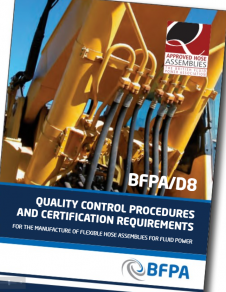Zero tolerance towards hose re-ending

Nigel Thomason, chairman of the British Fluid Power Distributors Association (BFPDA), condemns hose re-ending in the construction sector as the Association launches its ‘Choose Q for Quality’ campaign highlighting BFPA-approved quality members.
The pandemic has us all under extra strain and I know that many company owners or workers across the construction industry will be looking for ways to save money – but let me tell you now, reending hoses to save a few pounds is not the answer. That is why we’ve launched our latest campaign. We want to make sure that when you have a hose replaced, it is done by one of our Quality Approved Suppliers who categorically will refuse to re-end hose.
The BFPA Approved Hose Assemblies Scheme and the associated Q ‘Quality’ Logo sets practice guidelines for hose manufacturing, distribution and fitting. Members who sell and fit hoses in the scheme must meet strict criteria to carry the Q Mark, a sign of guaranteed quality, and to never practice hose reending.
Hydraulic hoses are found on almost every construction vehicle such as excavators and dumper trucks as well as many power tools and lifting devices and are subject to all types of weather conditions and can get accidentally damaged onsite. A pinhole leak in a hose can eject fluid at speeds of more than 180m (600 feet) per second; almost as fast as a bullet, depending on the pressure it is under. In my experience, few construction workers understand the dangers of pressure systems. A typical car tyre is around 32 PSI and a pressure of just 100 PSI (or 6.9 Bar) is enough to puncture the skin.
It is quite normal for fluid to be under pressure at 2000 PSI (168 Bar) in a hydraulic hose on a construction vehicle and can be as much as 6000 PSI (414 Bar). Oil under this much pressure will go straight through protective clothing, pierce the skin and can lead to severe, life-changing injuries from just one tiny looking pin prick. This type of injury can be caused as a direct result of hose re-ending which fundamentally changes the structural make-up of the hose leading to damage and deterioration.
Dangerous practice
Re-ending hoses is a dangerous practice that can lead to fatal injuries – ultimately, you are chancing with a liquid bullet. Cost is the biggest driver in re-ending, butit is the integrity of the whole assembly that is ruined when you do that, not just the end of a hose. Re-ending increases the risk of failure and is never covered by the hose manufacturer’s warranty, so it really is a false economy.
The BFPA is highlighting its campaign again now as COVID restrictions are placing the construction industry under much greater financial pressure, to caution against the temptation to re-end rather than use a Q Schemeapproved supplier.
Company owners should check that their current and future suppliers are a member of the scheme, which is now easier to do through the updated Hydraulic Hose Safety website (hydraulichosesafety.co.uk), which has an added ‘Find A Supplier’ section.
Efficiency
Choosing a supplier that carries the Q Mark ensures efficiency. If you think about it, if your construction equipment is fitted with the correct hose, in the right way, by a highly qualified individual, it is simply less likely to fail. This means less downtime waiting for repairs, which in turn increases productivity and projects are completed faster. And, most importantly, it allows company owners to sleep easy at night – knowing that the risk of a high-pressure injury from faulty practice has been eliminated.
Posters, counter display units and information cards are being provided for all scheme members to help reinforce the message: ‘Do not re-end hose’ with end users who still consider opting for this dangerous practice.
https://twitter.com/bfpaofficial https://www.linkedin.com/company/british-fluid-power-association/?trk=biz-companies-cym
-
PPMA 2025
23 September, 2025, 9:30 - 25 September, 2025, 16:00
NEC, Birmingham UK -
Advanced Engineering Show 2025
29 October, 2025, 9:00 - 30 October, 2025, 16:00
NEC, Birmingham UK










